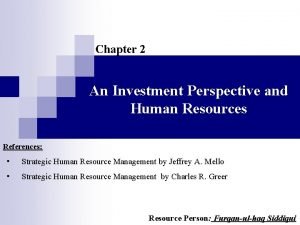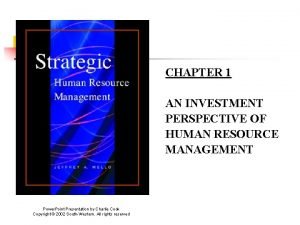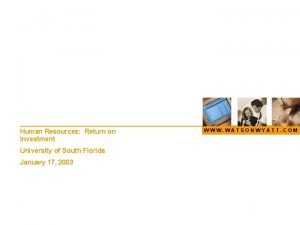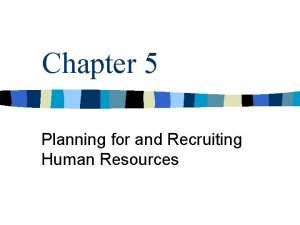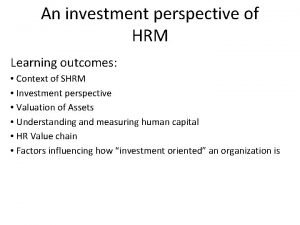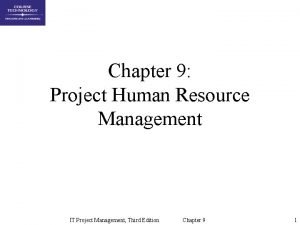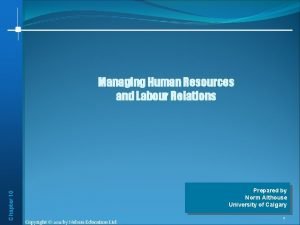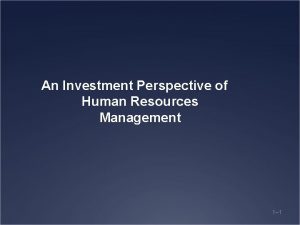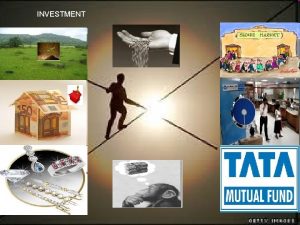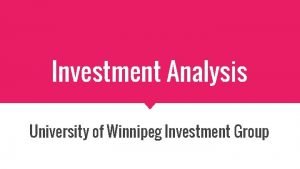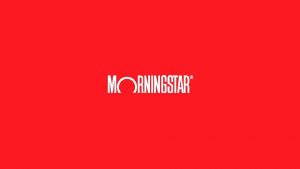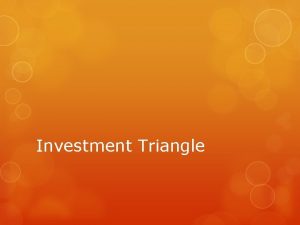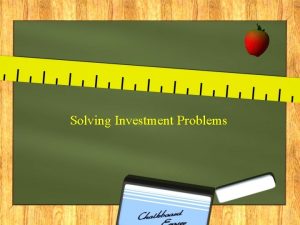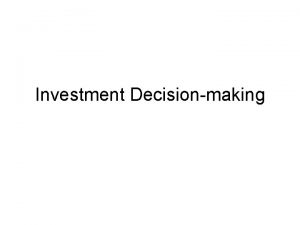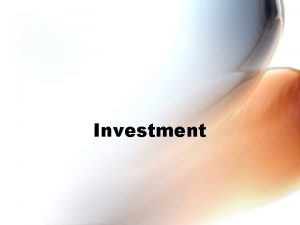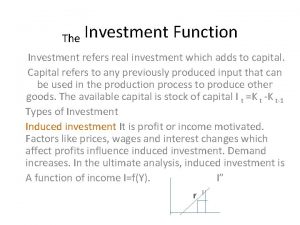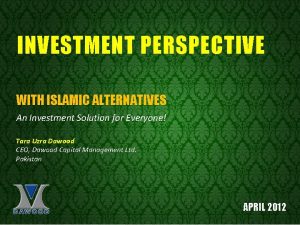Chapter 2 An Investment Perspective and Human Resources


















- Slides: 18

Chapter 2 An Investment Perspective and Human Resources References: • Strategic Human Resource Management by Jeffrey A. Mello • Strategic Human Resource Management by Charles R. Greer Resource Person: Furqan-ul-haq Siddiqui

An Investment Perspective and Human Resources


The Strategic View of Human Resources Employees are human assets that increase in value to the organization and the marketplace when investments of appropriate policies and programs are applied. n Effective organizations recognize that their employees do have value, much as same as the organization’s physical and capital assets have value. n Employees are a valuable source of sustainable competitive advantage. n

Sources of Employee Value

A Dilemma n Failure to invest in employees causes ¨Inefficiency ¨Weakening of organization’s competitive position n Human assets are risky investment ¨ HR are not owned by firm ¨ Can walk over to other organizations ¨ Cannot be duplicated ¨ Value of HR may decline ¨Require extra effort to ensure that they are not lost

Types of Organizational Assets/Capital

Valuation of Human Assets n Implications for Individuals and Organizations ¨ Determination of compensation Internal and external equity for employees in return for their contributions to the organization. n Organization placement of resources and returns on employee development are aligned and well-matched. n ¨ Advancement opportunities n Developing current employees creates motivation and permits promotion from within. ¨ Development of retention strategies n Effective means of retaining valuable employees allows for the recapture of the invested costs of their development.

The Investment-Oriented Organization n Organizational Characteristics ¨ Sees people as central to its mission/strategy. ¨ Has a mission statement and strategic objectives that espouse the value of human assets in achieving goals. ¨ Has a management philosophy that encourages the development and retention of human assets and does not treat or regard human assets in the same ways as physical assets.

Investment Orientation Factors

Investment Orientation Factors n Senior Management Values and Actions ¨ An organization’s willingness to invest in its human resources is determined by the “investment orientation” of its managers. n Attitude Toward Risk ¨ Investment in human resources is inherently riskier due to lack of absolute “ownership” of the asset. n Nature of Skills Needed by Employees ¨ The more likely that skills developed by employees are marketable outside the firm, the more risky the firm’s investment in the development of those skills.

n Utilitarian (“Bottom Line”) Mentality ¨ Quantifying the “soft” benefits of HR programs specially in short run is very difficult because they affect many different organizational areas and have differential effects on individual employees. ¨ More utilitarian an organization is, more likely it hesitate to invest on “soft” benefits. n Availability of Outsourcing ¨ If cost-effective outsourcing is available, investments will be made only in HR activities producing the highest returns and largest sustainable competitive advantages.

Human Capital n Human capital represents the human factor in the organization; the combined intelligence, skills and expertise that gives the organization its distinctive character. The human elements of the organization are those that are capable of learning, changing, innovating and providing the creative thrust which if properly motivated can ensure the long-term survival of the organization. Bontis et al (1999):


Understanding and Measuring Human Capital Human capital is considered a resource; an asset. Just as land, equipment, bonds, and stocks etc. n However, unlike other assets and resources, human capital is an intangible one, just like intellectual property or patents are. Intangible assets are no less valuable than tangible ones, it’s just that their value cannot be discerned by touch. n That being said, it is easy to see why there is no one, straightforward way of measuring human capital. Not only because it is intangible, but also because they are many variables that affect it. n



 Investment orientation
Investment orientation Investment perspective of human resource management
Investment perspective of human resource management Human resources return on investment
Human resources return on investment Fixed investment and inventory investment
Fixed investment and inventory investment Chapter 8 human resources culture and diversity
Chapter 8 human resources culture and diversity Chapter 8 study guide human resources culture and diversity
Chapter 8 study guide human resources culture and diversity Chapter 5 planning for and recruiting human resources
Chapter 5 planning for and recruiting human resources What is transformed resources
What is transformed resources Fixed resources definition
Fixed resources definition Investment perspective of shrm
Investment perspective of shrm Chapter 9 human resource management
Chapter 9 human resource management Chapter 27 human impact on earth resources
Chapter 27 human impact on earth resources Human resources introduction
Human resources introduction Chapter 9 human resources management
Chapter 9 human resources management Chapter 10 managing human resources
Chapter 10 managing human resources 3 point perspective stairs
3 point perspective stairs Silo perspective vs business process perspective
Silo perspective vs business process perspective Human needs and human development
Human needs and human development Chapter 8 human needs and human development
Chapter 8 human needs and human development
